Keeping your website up to date is not just a good habit; it’s crucial for your security, performance, and growth. Regular website maintenance helps ensure that your site operates smoothly, safeguards against cyber threats, and provides a seamless experience for users. This includes everything from routine updates and backups to performance evaluations and adjustments for Search Engine Optimization. A solid maintenance plan is key for businesses to remain competitive in the online landscape.
You might be wondering about the costs associated with website maintenance, what services are typically included, and which plans are best suited for small businesses or WordPress sites. This guide will provide you with all the information you need regarding maintenance services, pricing, and plans to keep your site secure and effective in 2025.
What Is Website Maintenance?
Website maintenance involves the continuous effort to keep your site updated, secure, and running smoothly. In simple terms, it encompasses everything necessary to ensure your website stays functional, safe, and appealing to visitors.
What Does Website Maintenance Include?
A website maintenance plan can cover tasks like:
- Updating software, plugins, and themes.
- Running backups and disaster recovery checks.
- Monitoring security and fixing vulnerabilities.
- Optimizing performance, speed, and uptime.
- Refreshing content and repairing broken links.
Website Design vs Website Maintenance
Website design is all about creating and launching a site, while website maintenance is what keeps it running smoothly afterward. You can think of design as laying the groundwork, and maintenance as the ongoing support that follows.
Why Website Maintenance Is Important
Ongoing maintenance helps:
- Protect against cyberattacks and downtime (security).
- Improve rankings through SEO maintenance.
- Provide a better user experience that converts visitors into customers.
- Reduce long-term website development costs by preventing major issues.
Why Is Website Maintenance Important for Businesses?
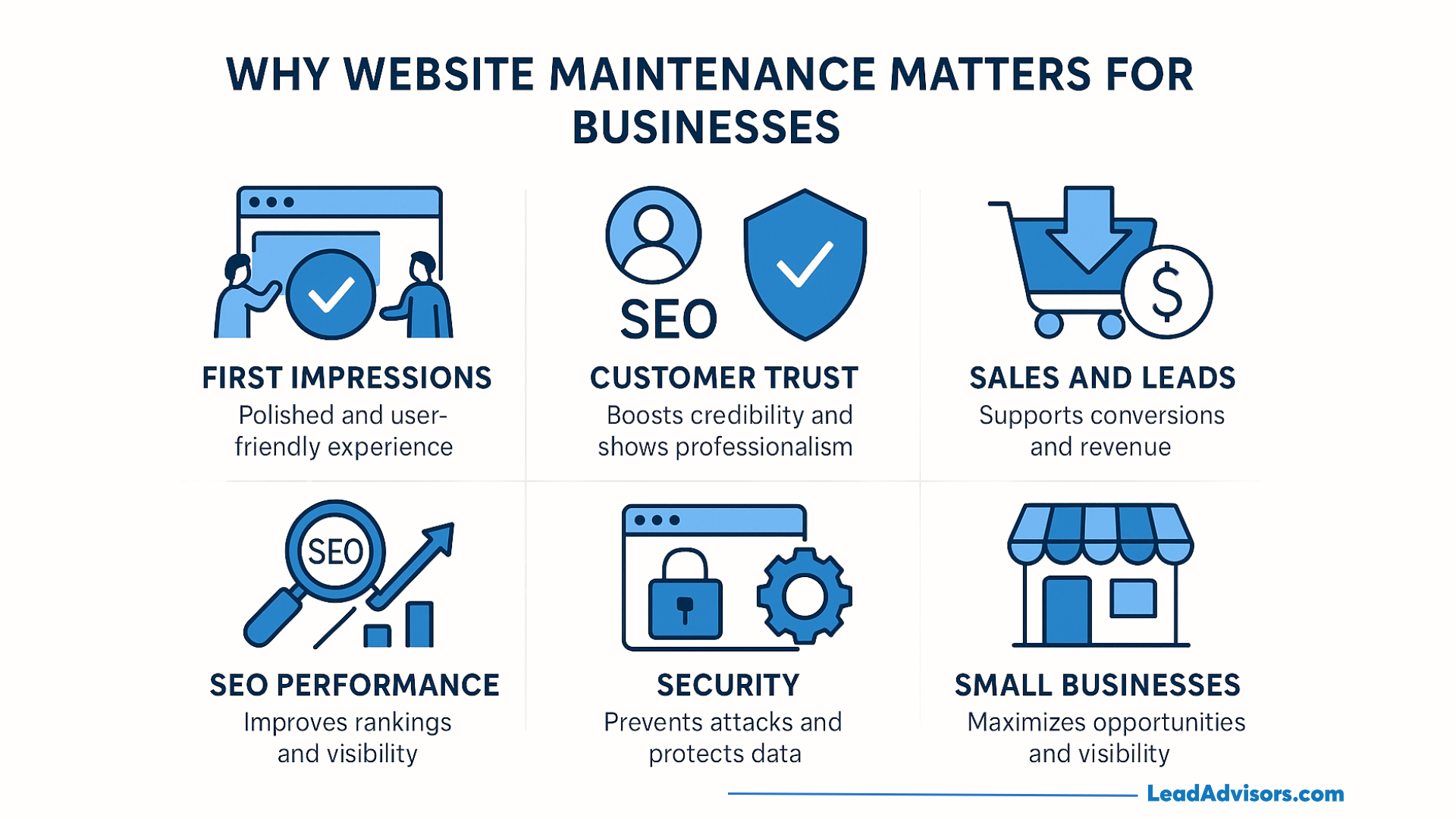
A well-kept website does more than just appear professional; it plays a crucial role in your brand’s success. Companies that prioritize regular website maintenance enjoy lasting benefits in terms of performance, trust, and revenue.
First Impressions and User Experience
Your website is often the first point of contact for potential customers. If it has slow loading times, broken links, or outdated content, it can lead to frustration and drive visitors away. Regular maintenance of your site helps ensure it remains polished, modern, and user-friendly.
Business Reputation and Customer Trust
Maintaining a strong business reputation and fostering customer trust is crucial. A website that looks neglected can damage your credibility, while a fast, secure, and regularly updated site conveys professionalism and builds trust with both new and returning customers.
SEO Maintenance Cost vs ROI
When it comes to SEO, the cost of maintenance is outweighed by the return on investment. Search engines favor well-maintained websites, leading to better rankings. By fixing errors, updating content, and optimizing performance, you can lower bounce rates and enhance visibility. Although maintaining a website incurs costs, the benefits include increased traffic and a more robust online presence.
Sales and Lead Generation
In terms of sales and lead generation, every moment of downtime or a malfunctioning checkout process can result in lost revenue. Reliable website support services ensure that forms, payment gateways, and conversion funnels operate smoothly, allowing you to capture leads and boost sales.
Website Security and Maintenance
As cyber threats continue to increase, outdated websites become easy targets. Regular updates, renewing SSL certificates, and conducting security scans are essential to safeguard sensitive customer information and avoid expensive breaches. Incorporating security into your website maintenance strategy is crucial.
Importance for Small Businesses
For many small businesses, a website acts as their main storefront. Consistent maintenance is vital for small business owners to protect their online presence, enhance visibility in local search results, and make the most of every potential lead, all without the need for a dedicated IT team.
What Is Included in Website Maintenance Services?
A professional website maintenance service covers a wide range of tasks that keep your site functional, secure, and optimized for growth. These services are typically divided into core maintenance tasks and specialized services depending on your business needs.
Core Maintenance Tasks
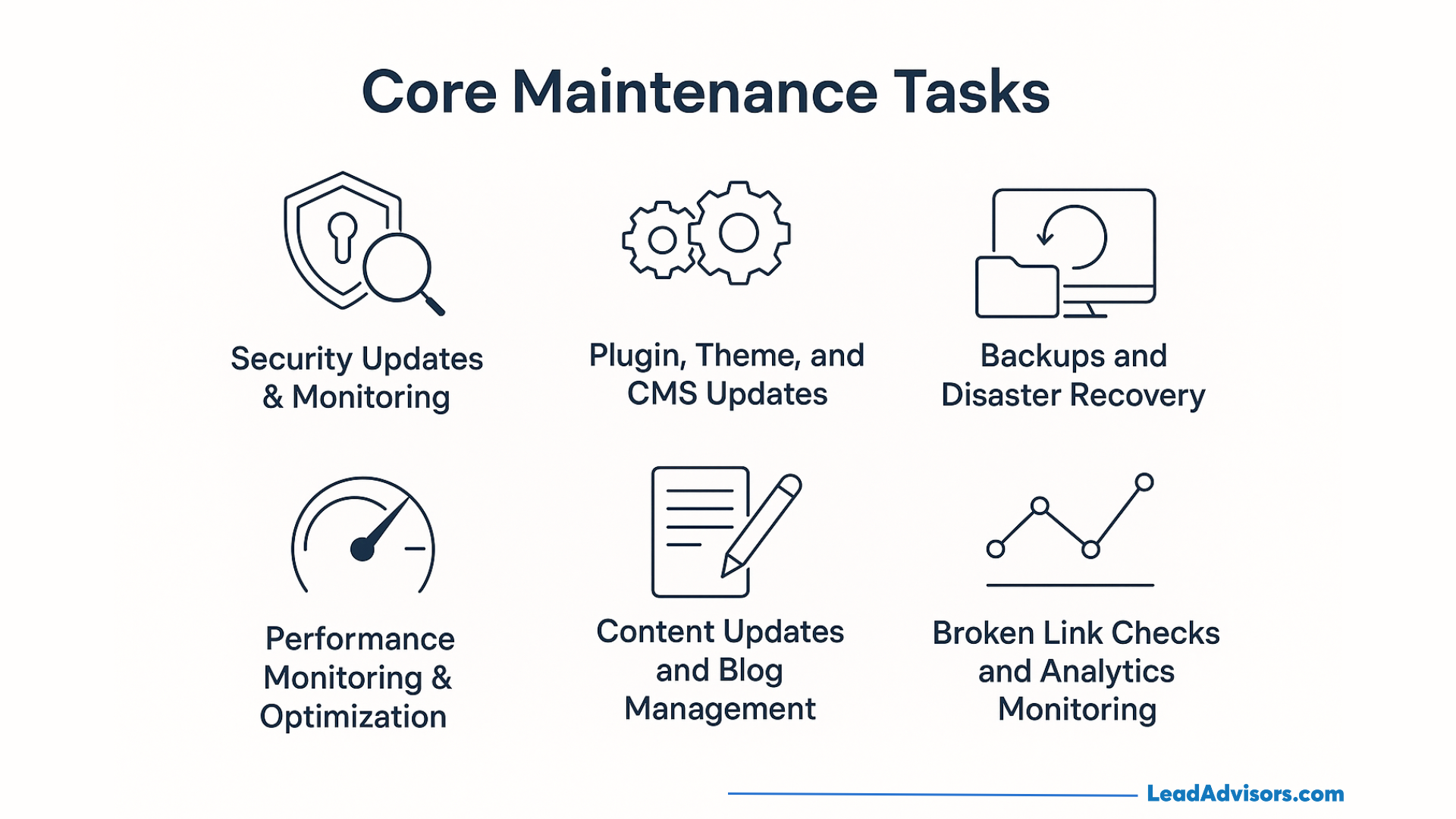
Security Updates & Monitoring
Effective website support and maintenance involves regular security checks, malware detection, and fixing vulnerabilities to safeguard sensitive information from cyber threats.
Plugin, Theme, and CMS Updates
For those using WordPress, maintenance tasks take care of ongoing updates for plugins, themes, and core files to avoid conflicts, bugs, or downtime.
Backups and Disaster Recovery
Consistent backups ensure that you can quickly restore your website in the event of data loss, hacking, or server issues. Having a disaster recovery plan helps reduce downtime and maintain business continuity.
Performance Monitoring & Optimization
Professional web maintenance services assess site speed, uptime, and overall performance. This includes optimizing images, implementing caching, and improving load times to provide a seamless user experience.
Content Updates and Blog Management
Keeping your website fresh and engaging for both users and search engines involves updating old content and publishing new blog posts regularly.
Broken Link Checks and Analytics Monitoring
Broken links can hurt your SEO and annoy visitors. Regular audits of links and reviews of analytics ensure your site consistently delivers valuable results and insights on search engines.
Specialized Maintenance Services
Ecommerce Website Maintenance
For online stores, keeping everything up to date is essential. This means regularly updating product listings, testing payment gateways, and making sure the shopping cart works smoothly – these steps are crucial to minimizing the chances of customers abandoning their purchases.
Compliance Checks
Today’s businesses need to adhere to various standards, such as the ADA for accessibility, GDPR for data privacy, and HIPAA for healthcare regulations. By focusing on compliance during maintenance, you can avoid potential legal issues.
Accessibility Testing and User Management
Ensuring that your website is accessible means that all visitors can use it effectively. Additionally, user management involves updating permissions and securing user accounts to protect sensitive information.
Hosting and Domain Renewals
Dependable website hosting and maintenance services include managing domain registration, DNS settings, SSL renewals, and upgrading hosting plans, all of which help keep your website running smoothly without any downtime.
Types of Website Maintenance Plans
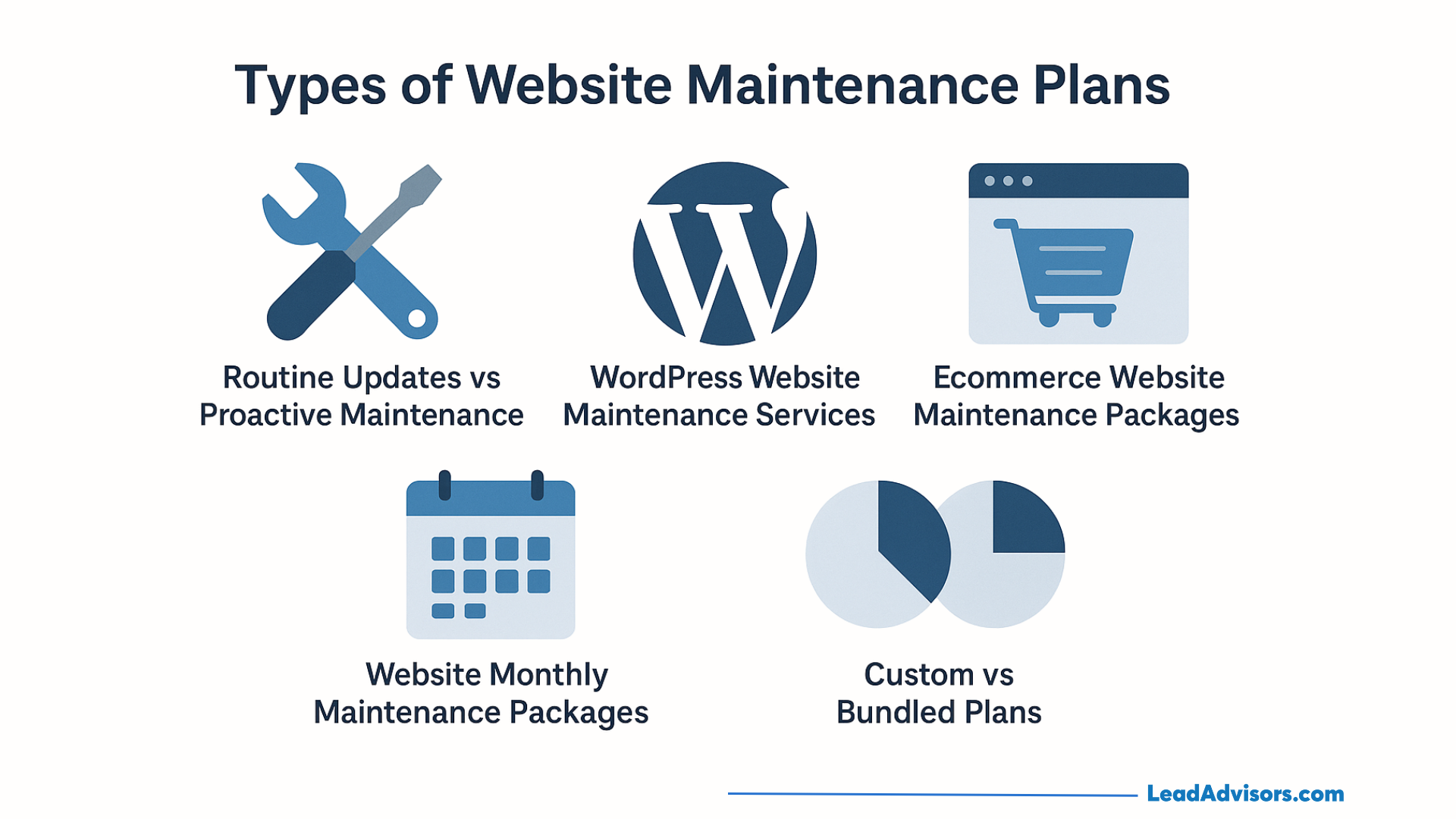
Website maintenance plans vary significantly based on the specific needs of each site. The ideal plan for you will depend on factors like your website platform, the size of your business, and your growth objectives. Generally, these plans can be categorized as follows:
Routine Updates vs Proactive Maintenance
Routine updates are all about essential tasks such as updating plugins, performing backups, and running security scans. On the other hand, proactive maintenance takes a more comprehensive approach, focusing on optimizing site performance, making SEO adjustments, and planning ahead to avoid potential issues.
WordPress Website Maintenance Services
Given that WordPress powers millions of sites, maintenance services tailored for WordPress are highly sought after. These services usually encompass plugin and theme updates, malware scans, uptime monitoring, and expert assistance for troubleshooting WordPress-specific problems.
Ecommerce Website Maintenance Packages
For online stores, specialized support is crucial to ensure that shopping carts, payment gateways, and inventory systems function seamlessly. Ecommerce maintenance packages typically offer 24/7 monitoring, checkout testing, and seasonal updates to manage increased traffic during peak times.
Website Monthly Maintenance Packages
Many web hosting companies provide monthly maintenance as part of their service offerings, which is perfect for businesses that require ongoing support. These plans generally include updates, backups, and analytics reviews for a consistent monthly fee, allowing businesses to budget effectively.
Custom vs Bundled Plans
While small businesses might only need basic updates, larger companies often require more advanced services like compliance monitoring, performance audits, and content management. Custom plans offer flexibility, whereas bundled plans deliver a set of standard services at a fixed price. Selecting the right option ensures your website receives the appropriate level of care without unnecessary expenses.
How Much Does Website Maintenance Cost?
When it comes to website maintenance, a common question that arises is: How much does maintenance cost? The answer varies based on factors like the size of your site, the platform you’re using, and the specific services you need. Generally, you can expect to pay anywhere from $50 to over $5,000 each month, depending on whether you manage it yourself, hire freelancers, or engage a professional agency.
What Is the Average Cost of Website Maintenance?
So, what’s the typical cost for maintaining a website? For small business websites, the monthly expense usually falls between $50 and $300. In contrast, ecommerce sites or larger enterprise websites often allocate a budget of $1,000 to $5,000 per month for more comprehensive support. These expenses typically include security measures, hosting, content updates, and ongoing optimization efforts.
Cost Breakdown by Service
| Service | Typical Cost Range |
| Domain Name & Hosting | Domain renewals: $10–$20/year. Hosting: $10/month (shared) to $500+/month (enterprise) |
| SSL Certificate & Security | SSL: $0–$300/year, Advanced security monitoring: $50–$200/month |
| Plugins & Software Updates | Premium plugins/extensions: $50–$200/year each. Update management: additional ongoing cost |
| Design Refreshes & Content | $100–$1,500 depending on project scope and frequency |
| Technical Support | $50–$200/hour, or included in monthly website maintenance packages |
Cost Factors
- Website Size & Complexity – Maintaining larger websites with numerous pages on search engines, users, and integrations typically requires more resources.
- Type of CMS (WordPress, Wix, Shopify) – Different platforms come with varying needs for updates and support.
- Maintenance Frequency – The cost can be influenced by how often maintenance is performed, whether it’s weekly, monthly, quarterly, or annually.
- Website Maintenance Service Providers – While freelancers might offer lower rates, agencies usually bring a broader range of expertise and services.
- Regional Cost Differences – The cost of web maintenance can differ significantly based on the provider’s location, such as between U.S. and offshore support.
Pricing Models
| Category | Details / Cost Range |
| Cost of Website Maintenance Per Month | $50 – $1,500 depending on scope (flat monthly fee for bundled services). |
| Average Website Cost vs Ongoing Maintenance | Website build: $1,000 – $30,000+ Ongoing maintenance: recurring $50 – $5,000+/month. |
| Hourly, Retainer & Package Pricing | Freelancers: $50 – $150/hour. Agencies: $500 – $2,000/month (retainers/packages). |
| Website Development vs Maintenance Cost | Development = one-time investment, Maintenance = recurring; ignoring it raises future costs. |
| How Much to Charge (Freelancer/Agency) | Freelancers: $50 – $100/month basic update.s Agencies: $500 – $5,000+ for full plans. |
How Long Does Website Maintenance Take?
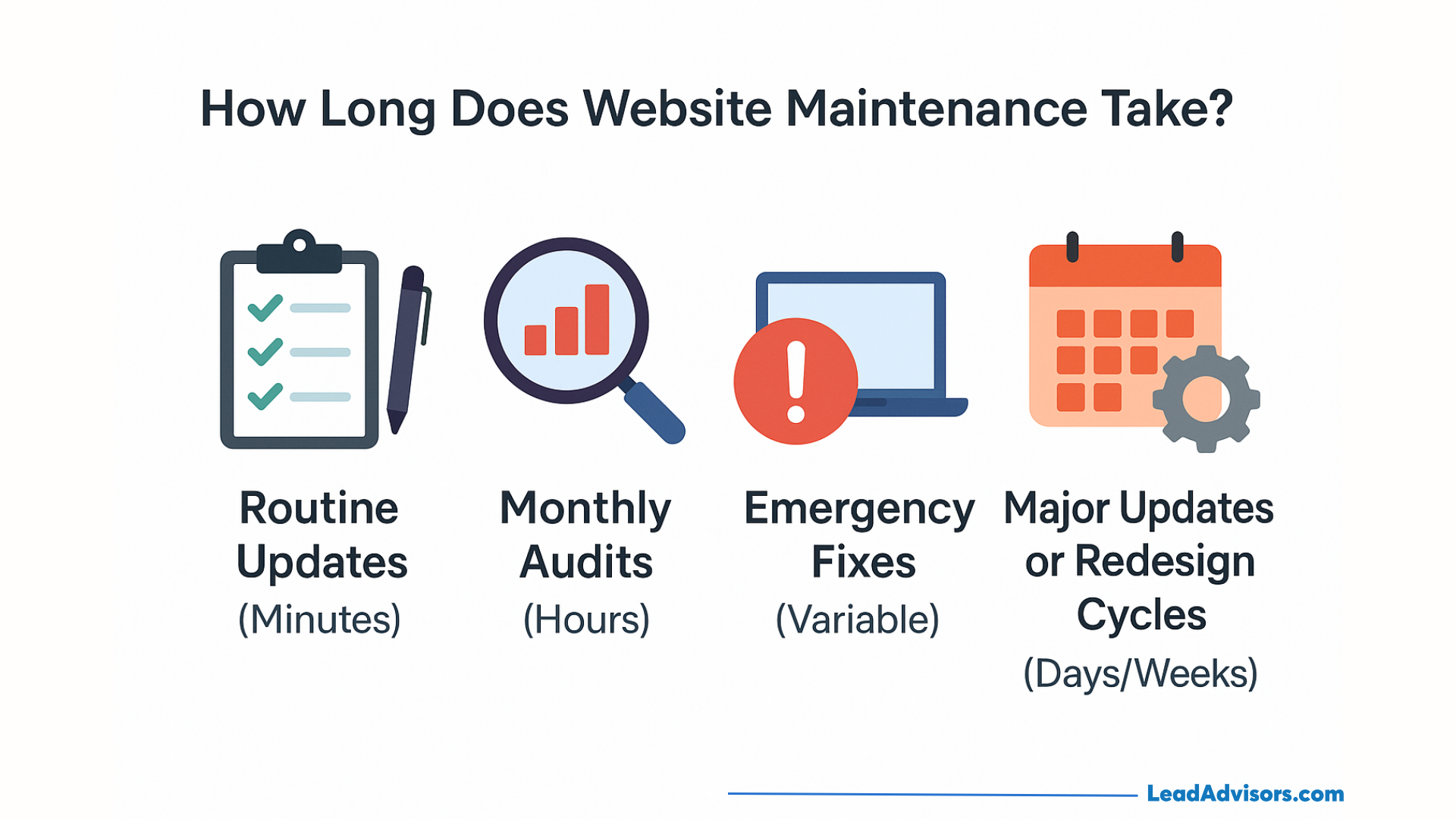
Website maintenance time varies based on the specific tasks and the complexity of your site. Some updates can be completed in just a few minutes, while larger projects might take days or even weeks.
- Routine Updates (Minutes)
Simple tasks such as updating plugins, applying security patches, or making minor content changes usually take about 5 to 30 minutes.
- Monthly Audits (Hours)
More comprehensive maintenance, which includes checking analytics, fixing broken backlinks, or optimizing site performance, generally requires 2 to 4 hours each month.
- Emergency Fixes (Variable)
Unexpected problems like server crashes, malware infections, or checkout errors can take anywhere from a few minutes to several hours to resolve, depending on their severity.
- Major Updates or Redesign Cycles (Days/Weeks)
Significant changes, such as migrating to a new Content Management System, redesigning templates, or rebuilding features, can take anywhere from a few days to several weeks.
Having a well-structured website maintenance plan allows businesses to effectively manage both routine and long-term tasks, minimizing unexpected delays.
Should You Maintain Your Website Yourself or Hire a Professional?
When it comes to website maintenance, businesses face two choices: handling updates in-house or hiring a professional website maintenance company. Both approaches have advantages and trade-offs depending on your goals, budget, and technical expertise.
DIY Website Maintenance
Pros and Cons for Small Businesses
- Pros: Lower cost, full control over updates, and flexibility in scheduling.
- Cons: Time-consuming, requires technical knowledge, and carries a higher risk of mistakes.
Tools for DIY Website Upkeep
- WordPress plugins like ManageWP and UpdraftPlus for backups and updates.
- Security scanners such as Sucuri or Wordfence.
- Site’s performance monitoring tools like Google PageSpeed Insights and GTmetrix.
Risks of Neglecting Professional Support
Small businesses may overlook critical tasks such as advanced security checks or disaster recovery. Missing these steps can lead to downtime, lost sales, or expensive fixes later.
Hiring a Website Maintenance Company
What Makes a Good Website Maintenance Agency?
A reliable agency should offer proactive monitoring, transparent reporting, and clear website maintenance tasks tailored to your business. Look for expertise in your CMS (e.g., WordPress or Shopify) and strong customer support.
Best Website Maintenance Companies (Examples for WordPress & Ecommerce)
- WP Buffs: Popular for unlimited WordPress edits.
- SiteCare: Offers custom WordPress development and support.
- Mageplaza: Specializes in Magento ecommerce maintenance.
- WP Maintainer: Affordable for small businesses and beginners.
- Cost Comparison: Self-Maintaining vs Outsourcing
- DIY: $50–$150/month in tools and plugins, but a higher time investment.
Professional Agency: $500–$5,000/month, depending on service level and site complexity. While costlier, outsourcing provides expertise, 24/7 monitoring, and peace of mind.
Website Maintenance Process: Step-by-Step Guide
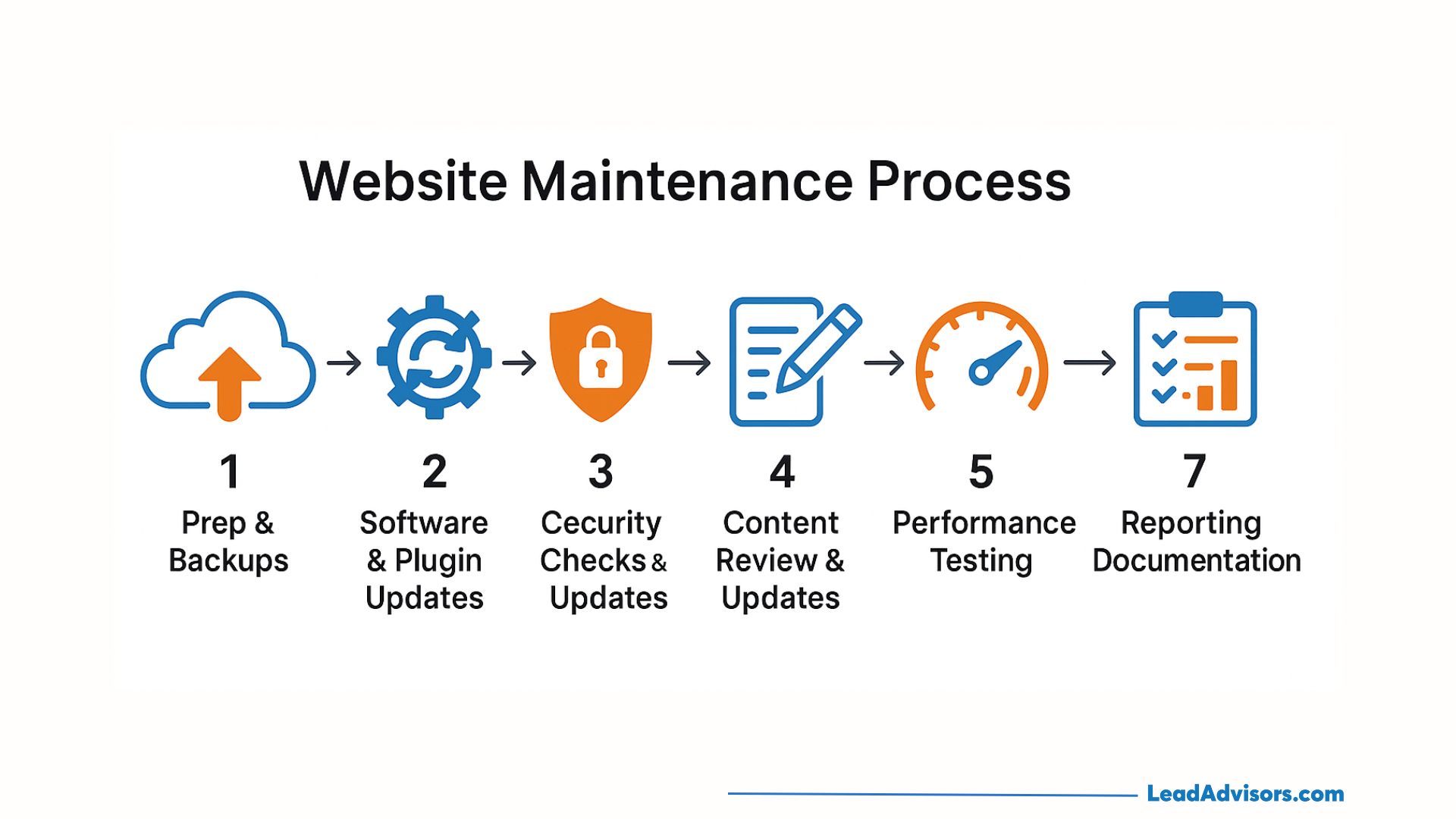
Having well-organized website maintenance tasks is crucial to ensure that nothing is missed. By following a clear step-by-step method, you can keep your site secure, fast, and ready for growth.
1. Preparation & Backups
Before making any changes, it’s essential to create a complete backup of your site, including databases, themes, and content. This way, you can quickly restore everything if something goes wrong.
2. Software & Plugin Updates
Regularly update your CMS, themes, and plugins. Outdated software can lead to significant security vulnerabilities.
3. Security Checks and Scans
Conduct malware scans, update SSL certificates, and keep an eye on firewalls. Taking proactive security measures helps prevent downtime and data breaches.
4. Content Review & Updates
Take the time to refresh outdated information, fix broken links, and add new blog posts or product details. Keeping your content updated engages users and supports SEO efforts.
5. Performance Testing
Utilize tools like Google PageSpeed Insights or GTmetrix to assess load times and pinpoint any bottlenecks. Optimize images, scripts, and hosting settings to enhance speed.
6. Analytics Review
Review traffic data, bounce rates, and conversion funnels. Monitoring your analytics helps you spot issues early and track the effectiveness of your website maintenance plan.
7. Reporting and Documentation
Keep a record of completed updates, performance changes, and any outstanding issues. Regular reports provide transparency and help measure long-term success.
Website Maintenance for Different Platforms
Different platforms require unique maintenance approaches. While some tasks are universal, WordPress, Wix, and ecommerce sites all have platform-specific requirements that businesses should understand.
WordPress Website Support Services
- WordPress-Specific Tasks
Keeping a WordPress site running smoothly requires regular updates to themes, plugins, and the CMS itself. It’s also essential to perform regular backups, conduct security scans, and optimize hosting to ensure everything operates efficiently.
- WordPress Maintenance Companies
Companies such as WP Buffs, SiteCare, and WP Maintainer focus on providing support services for WordPress websites. They handle everything from managing plugins to troubleshooting emergencies, making them perfect for businesses that lack in-house developers.
- How to Put a WordPress Website in Maintenance Mode
WordPress has a built-in maintenance mode for updates, or you can opt for plugins like WP Maintenance or SeedProd to temporarily take your site offline while showing a custom “under maintenance” message to your visitors.
Wix Website Maintenance
- How to Put a Wix Website Under Maintenance
While Wix may not provide the same level of flexibility as WordPress, you can still hide your site from visitors or show a maintenance message through the settings in the Wix dashboard.
- Limitations vs WordPress
In contrast to WordPress, Wix offers limited control over server-side updates and plugin customization. Although it’s user-friendly for beginners, it lacks the flexibility that businesses often require for more advanced website maintenance services.
Ecommerce Website Maintenance
- Shopify, Magento, WooCommerce
Platforms like Shopify, Magento, and WooCommerce need specific upkeep. This involves refreshing product listings, checking the checkout process, and keeping an eye on payment gateway connections.
- Importance of Uptime and Checkout Testing
Any downtime or issues during checkout can hurt sales. It’s crucial to regularly monitor uptime, optimize speed, and conduct security checks to safeguard revenue and provide a seamless shopping experience.
How to Project Manage Website Maintenance Effectively
Managing website maintenance can feel overwhelming without the right structure. By treating maintenance as an ongoing project, businesses can stay organized, track progress, and avoid costly oversights.
Setting Up Workflows with Asana, Trello, or ClickUp
Project management tools make it easy to assign tasks, set deadlines, and monitor progress. For example:
- Use Asana to schedule recurring tasks like backups or plugin updates.
- Organize Trello boards for security checks, content updates, and design changes.
- Leverage ClickUp for more advanced workflows, including integrations with analytics and reporting tools.
Tracking Website Support Tickets
Professional website support services often include ticketing systems for handling bugs, outages, or update requests. Tracking tickets ensures issues are logged, prioritized, and resolved efficiently.
Outsourcing Website Maintenance Tasks
If managing everything in-house isn’t practical, outsourcing can save time and reduce risk.
- Freelancers: Cost-effective for small updates but may lack full coverage.
- Agencies: Provide comprehensive website maintenance services with proactive monitoring, reporting, and dedicated support.
By combining clear workflows, support tracking, and outsourced expertise when needed, businesses can create a scalable website maintenance plan that minimizes downtime and maximizes performance.
Frequently Asked Questions
What is a website maintenance plan?
How much should website maintenance cost?
What is included in website maintenance services?
How much does website maintenance cost per month?
Why is WordPress website maintenance important?
How to sell website maintenance services?
What should I know about website maintenance?
Final Thoughts
Website maintenance is crucial for ensuring your site remains secure, fast, and dependable. It protects against cyber threats, enhances SEO performance, and guarantees a smooth user experience. Regular maintenance is truly an investment that leads to stability and growth.
Whether you opt for a DIY method or collaborate with a professional maintenance service, having a well-structured maintenance plan helps your business avoid expensive downtime and missed opportunities.
Are you ready to safeguard and enhance your online presence? Check out customized website maintenance plans designed to meet your business needs and keep your site performing at its best.












